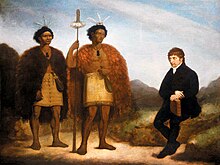Waikato (rangatira)
Appearance


Waikato (c. 1790 – 17 September 1877), sometimes known as Waikato Piriniha or Prince Waikato, also known as Hohaia Parata or Hohaia Parati, was a tribal leader (rangatira) of the Ngāpuhi and Te Hikutū iwi (tribes).[1] Waikato's primary residence was the pā at Rangihoua Bay.[2]
As a young man, Waikato travelled to England in 1820 alongside the principal Ngāpuhi chief Hongi Hika and the missionary Thomas Kendall. Hongi Hika and Waikato had assisted Kendall with developing a written form of the Māori language and in England, they worked with the linguist Samuel Lee at the University of Cambridge in the preparation of a grammar and vocabulary of the language. The chiefs had an audience with King George IV.[2]
References
[edit]- ^ Foster, Bernard John, ed. (1966). "Waikato, or Hohaia Parati". An Encyclopaedia of New Zealand. Ministry for Culture and Heritage / Te Manatū Taonga. Retrieved 5 July 2023.
- ^ a b "Waikato". Ministry for Culture and Heritage. Retrieved 23 July 2023.
